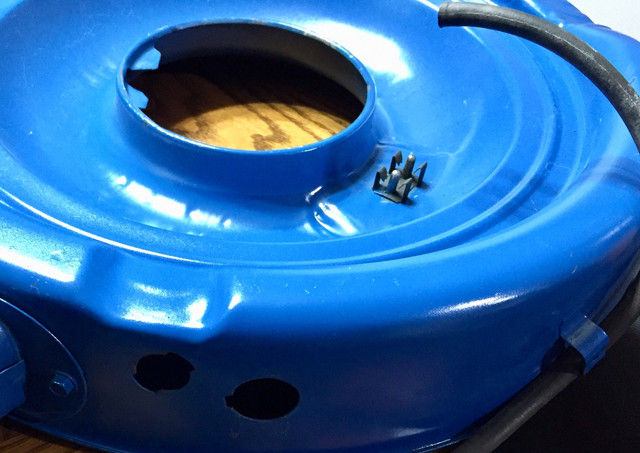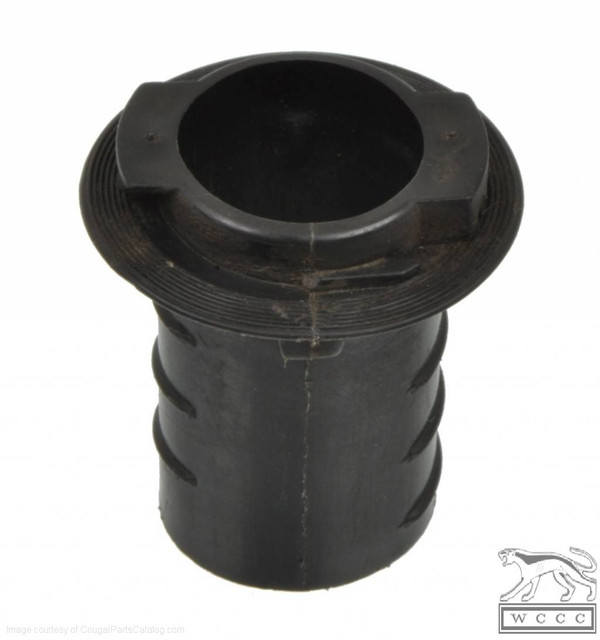You are using an out of date browser. It may not display this or other websites correctly.
You should upgrade or use an alternative browser.
You should upgrade or use an alternative browser.
Air Cleaner Fittings
- Thread starter cheezsnake
- Start date

Help Support 7173Mustangs.com:
This site may earn a commission from merchant affiliate
links, including eBay, Amazon, and others.
I had the same questions a while back. Heres my thread and answers to your question
https://www.7173mustangs.com/thread-air-cleaner-help
https://www.7173mustangs.com/thread-air-cleaner-help
cheezsnake
Well-known member
Thanks for the link! Very helpful. Is the vacuum valve? with the 2 tubes in the center of the cleaner something that’s reproduced? If it’s available, I’d like to replace it.
- Joined
- Sep 12, 2015
- Messages
- 8,016
- Reaction score
- 3,110
- Location
- SW Ontario
- My Car
- 1971 Mustang Mach 1, M code, 4 speed.
That is the temp sensor for the snorkel vacuum motor. It normally opens the hot air by-pass on cold start-up and closes it as the motor warms up.Thanks for the link! Very helpful. Is the vacuum valve? with the 2 tubes in the center of the cleaner something that’s reproduced? If it’s available, I’d like to replace it.
They were calibrated to suit different applications and are not a one size fits all. As for being reproduced, I'm not sure. The snorkel vacuum motors are but at a ridiculous price.
All these parts were made at the factory where I worked. Wish I'd snagged a box or two of these parts, I'd be rich now!!

$34.49
$42.95
Mustang by Design: Gale Halderman and the Creation of Ford's Iconic Pony Car
USA Speed

$13.39
$16.39
Ford Mustang: Trivia & Fun Facts Every Fan Should Know About The Great American Icon!
Amazon.com

$64.98
JH DESIGN GROUP Men's Ford Mustang Collage Black Zip Up Hoodie Sweatshirt (Large, CLG2-black)
Affordable Family Clothing

$9.00
2016 Hot Wheels Vintage American Muscle 1970 FORD MUSTANG MACH 1 die-cast 4/10
Cards and Bobbles

$24.95
Ford Mustang Pony Racing Stripe 5.0 Muscle Shelby Long Sleeve T-Shirt Front Back Print-Black-Large
Giftware Shop Usa

$19.80
$25.00
Ford Mustang: Fifth Generation / S197 2005-2014 (The Essential Buyer's Guide)
Amazon.com

$29.70
Ford Mustang, Mach 1, GT, Shelby, & Boss V-8 (64-73) Haynes Repair Manual
Haynes Repair Manuals

$52.03
Scott Drake Ignition/Door/Trunk Lock Set, Compatible with 1967-1969 Ford Mustang, Model C7AZ-6222050-MK
Kentucky Mustang Parts

$30.49
$55.00
The Complete Book of Ford Mustang: Every Model Since 1964-1/2 (Complete Book Series)
Amazon.com

$31.51
$60.00
Shelby American 60 Years of High Performance: The Stories Behind the Cobra, Daytona, Mustang GT350 and GT500, Ford GT40 and More
WhitePaper Books

$99.99
Polished Rocker Panel Sill Plate Molding Kit with Clips Compatible with 1964-1966 Ford Mustang - Authentic Restoration for Classic Car Enthusiasts
Classic 2 Current Fabrication
cheezsnake
Well-known member
Thanks!
cheezsnake
Well-known member
OK. So, if I understand this correctly, one side of the temp sensor is supplied with manifold vacuum, and the other side goes to the snorkel vacuum motor. When the engine is cold, the temp sensor allows manifold vacuum to pull the motor door closed, routing warm air from above the exhaust manifold into the air cleaner. As the engine warms, the temp sensor closes vacuum to the snorkel motor, which opens the door to the cooler engine compartment air. If I have that right, here's my question ...
Shouldn't the temp sensor hold vacuum? If I connect the manifold side to a vacuum source (tester), and I plug the other side, the temp sensor vacuum bleeds down quickly. I'm concerned if I hook the lines up on the engine, this will be the source of a vacuum leak. I have 2 of these temp sensors, and they both behave the same way. What am I missing?
Thanks.
Shouldn't the temp sensor hold vacuum? If I connect the manifold side to a vacuum source (tester), and I plug the other side, the temp sensor vacuum bleeds down quickly. I'm concerned if I hook the lines up on the engine, this will be the source of a vacuum leak. I have 2 of these temp sensors, and they both behave the same way. What am I missing?
Thanks.
- Joined
- Sep 12, 2015
- Messages
- 8,016
- Reaction score
- 3,110
- Location
- SW Ontario
- My Car
- 1971 Mustang Mach 1, M code, 4 speed.
Yes to the first part. It does need to be connected correctly for it to work. You may have to try with vacuum to each side to verify.OK. So, if I understand this correctly, one side of the temp sensor is supplied with manifold vacuum, and the other side goes to the snorkel vacuum motor. When the engine is cold, the temp sensor allows manifold vacuum to pull the motor door closed, routing warm air from above the exhaust manifold into the air cleaner. As the engine warms, the temp sensor closes vacuum to the snorkel motor, which opens the door to the cooler engine compartment air. If I have that right, here's my question ...
Shouldn't the temp sensor hold vacuum? If I connect the manifold side to a vacuum source (tester), and I plug the other side, the temp sensor vacuum bleeds down quickly. I'm concerned if I hook the lines up on the engine, this will be the source of a vacuum leak. I have 2 of these temp sensors, and they both behave the same way. What am I missing?
Thanks.
It's been many years since I worked with them, but if I remember correctly, the temp sensor is just that, a temp sensor. It has a bimetal strip inside that normally keeps the vacuum valve inside open, therefore the snorkel door will be open to outside air. When vacuum is applied on a cold engine at start-up, vacuum from the manifold pulls the diaphragm in the vacuum motor which in turn closes the inlet and opens the heat riser bypass. As the engine warms up, the bimetal strip closes the vacuum and the spring inside the VM opens the inlet thus closing the heat bypass, i.e. there is no vacuum applied. If it wasn't so damn cold still here in the garage, I'd go test mine and confirm. The temp valve will need to hold vacuum, but I'm not sure if you can test it separately from the VM. Tomorrow is supposed to be much warmer and as I am getting anxious to get my newly rebuilt 4 speed shifter back in as well as swapping out the PS box for the newly rebuilt one I did myself, I might be able to check and get back on this.
Geoff.
Last edited by a moderator:
cheezsnake
Well-known member
Just following up for those that might be interested. Apparently, you can't bench test those temp sensors with a vacuum source, or at least not the way I tried it. The installed temp sensor is connected to vacuum on the running engine, and it's running fine ... does not seem to have caused a leak.
- Joined
- Aug 30, 2014
- Messages
- 1,591
- Reaction score
- 415
- Location
- Delaware
- My Car
- Stock 1973 Mustang Convertible with a 351C 2v and C6
Modified 1970 Mach 1 M-Code with a 351C 4v Manual
I bench tested mine by hooking up two short length vacuum hoses with a vacuum pump/brake bleeder on one end. I then submerged the bi-metal valve in hot tap water and pumped up the vacuum to 10-15 lbs. If you have the pump on the correct side of the valve and the valve is working properly, the pump should hold vacuum. If not try switching the pump to the hose on the other side or check your hoses for leaks. After a few minutes of it holding vacuum in the hot water bowl, I removed the valve (still holding vacuum and submerged it a bowl of cold ice water, which will cause a properly functioning valve to open and the vacuum to be released.
Last edited by a moderator:
- Joined
- Sep 12, 2015
- Messages
- 8,016
- Reaction score
- 3,110
- Location
- SW Ontario
- My Car
- 1971 Mustang Mach 1, M code, 4 speed.
+1. good test.I bench tested mine by hooking up two short length vacuum hoses with a vacuum pump/brake bleeder on one end. I then submerged the bi-metal valve in hot tap water and pumped up the vacuum to 10-15 lbs. If you have the pump on the correct side of the valve and the valve is working properly, the pump should hold vacuum. If not try switching the pump to the hose on the other side or check your hoses for leaks. After a few minutes of it holding vacuum in the hot water bowl, I removed the valve (still holding vacuum and submerged it a bowl of cold ice water, which will cause a properly functioning valve to open and the vacuum to be released.
Similar threads
- Replies
- 13
- Views
- 1K
- Replies
- 0
- Views
- 112
- Replies
- 0
- Views
- 382
- Replies
- 22
- Views
- 1K










































